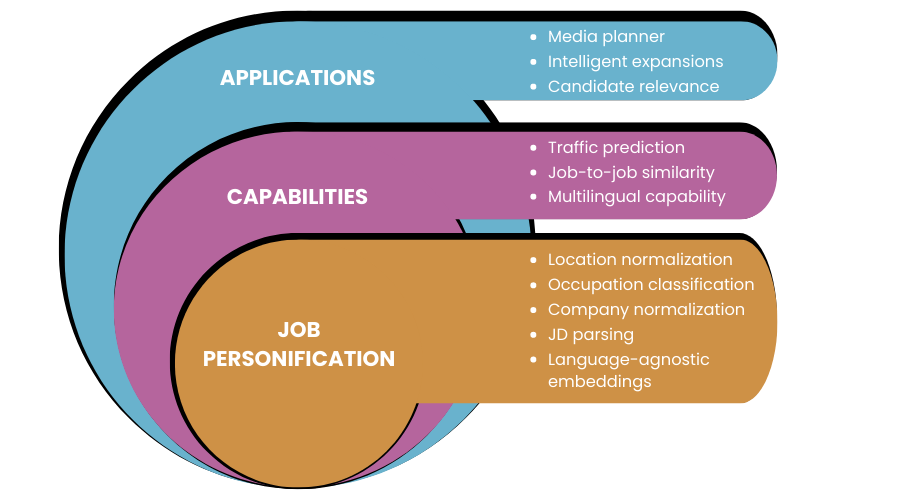Optimization is a part of our daily life at Joveo, where teams try to reach billions of job seekers in the shortest amount of time, with the lowest budget possible. Key members of the process, our Data Science team is staffed by creative, can-do people who thrive on solving complex problems – they are an integral part of Joveo, as we strive to achieve our mission.
Why we exist
Joveo exists to help organizations find the talent they need. We aspire to replace the guesswork and complexity of today’s recruiting with intelligence and transparency. This means we must deliver greater certainty across the recruitment funnel and squeeze the last ounce of efficiency from our business processes.
That’s where the data science function comes in; we help customers do more with less. The data science team focuses on building and maintaining a world-class suite of forecasting algorithms and integrating them into our business intelligence stack. We partner closely with the business solutions team to provide as much information as we can to our customer success executives, so that – combined with their industry experience – they can make the best decisions for our customers. Broadly, this comprises recommendation systems, data visualization, and automations.
What we do
Being a data scientist is like being a hybrid of a librarian and a Swiss army knife: Two good things to have on hand when you’re working with gargantuan data sets. Like a librarian, Joveo’s data scientists have access to an encyclopaedia of knowledge on ad operations, recruitment operations, publisher operations, and job supply and demand. And, like a Swiss army knife, data scientists have multiple tools to get the job done – be it NumPy, Pandas or NLP tools, like SciPy and Gensim. We work with state of the art transfer learning models, such as BERT, for language models, and predictive modelling techniques like xgboost and gradient boosting.
One of the best things about being a Data Scientist at Joveo is the variety. You have some days where you’re brainstorming and collaborating with amazing colleagues and other days where you can put on your headphones and work out a challenging problem or build a dashboard.
Let’s dive into the numbers, with the latest talent sourcing and recruitment advertising benchmarks!
Ready to Let the Data Do the Talking?
Making jobs more accessible to everyone
Broadly, the data science team works across three hierarchies of problem statements in job advertising:
1. Job Personification: This is the fundamental building block of our problem statement – processing and analyzing the content of job advertisements to extract meaningful information and organize jobs. For example, job personification can be used to:
- Identify and normalize job locations (city, state, country)
- Classify jobs into a standard known operation
- Parse the job description to extract desired entities
- Tag named entities in the job title to predefined categories
- Identify the normalized industry and company the job belongs to
- Make our solutions language agnostic
2. Capabilities: This is the second hierarchical level our data science team works on – where they combine one or more outputs from job personification into reusable artifacts which can then be used to identify patterns and find a wide range of other applications:
- A job’s similarity with other jobs, with respect to trading strategy
- A job’s similarity with other jobs, with respect to candidate’s interest
- Predicting traffic (clicks and predictions) given a personified job
- Job-to-candidate matching and search
- Predicting whether a candidate is active or passive
3. Applications: This outermost layer comprises user-facing applications. We identify user problems by maintaining a vantage point over every piece of the business and gaining a complete understanding of their journeys, pain-points, and opportunities. We act as a “guide on the side,” by closely familiarizing ourselves with business needs on a regular basis. Examples include:
- Recommending publishers and bids to get maximum traffic
- Expanding jobs to neighbouring cities
- Suggesting alternate titles to boost traffic
- Fetching top relevant candidates for given job
- Early warning dashboard for job’s poor performance

One way to understand this is to imagine trying to play a game of cricket. Your eyes, hands, and legs are fundamental. You would not be able to proceed without them. Using these body parts, you develop basic capabilities such as running, hand-eye coordination, and shoulder rotation. Finally, you combine these capabilities into specialized applications for cricket, such as batting, bowling and fielding.
Every quarter, we pick and focus on a set of problems from each layer. If you are thinking about joining the team, you would work with a cross functional pod around each problem, consisting of data scientists, software engineers, designers, and product managers. These pods are decentralized, semi-autonomous units. The team also puts code into production, sets up the environment to deploy the model, improves response times, and oversees data pipelines. The great thing about our pods is that everyone contributes different skills and ideas. The team benefits from both individual strengths and willingness to collaborate – helping us build a culture centered around inclusivity and collective problem solving.
If this article resonates with you and you’d like to explore opportunities with Joveo, check out our career site and learn about our technology. You can also find more stories on how we are pushing the envelope in programmatic job advertising here. And follow us on Twitter and LinkedIn.















